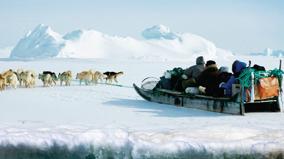New release
Coming
None
On the Ice Floe
2012
27 min
Leaving soon
This short documentary depicts a warm yet ephemeral community that comes together on the ice in Rimouski, Quebec—the site of an unusual encounter between ice fishermen and French artist Joseph Kieffer.

Details
This short documentary depicts a warm yet ephemeral community that comes together on the ice in Rimouski, Quebec—the site of an unusual encounter between ice fishermen and French artist Joseph Kieffer.
-
directorStéphane Lahoud
-
associate producerAndré Mailly
-
producerEvelyne Lafleur GuyJohanne BergeronJacques Turgeon
Education
Ages 10 to 18
School subjects
Joseph Kieffer wants to turn stories and “drawings into objects” (10:45). While the fishermen participate, they are unsure how to receive his work. Ask students to consider the two men (21:50 and 24:30) who take great pride in their own handiness, as well as the comments (14:00) about how someone with a “different character” will be able to recreate their stories. What can be observed about community and tradition from these statements?

















